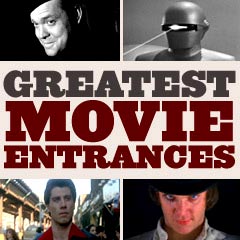
|
| Movie Title/Year and Film Character with Scene Description | |||||||||||
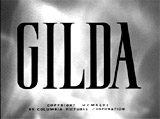
|
In Charles Vidor's romantic noir, crippled Buenos Aires casino owner Ballin Mundson (George Macready) entered his inner bedroom suite with gambler and right-hand man Johnny Farrell (Glenn Ford), where a woman was singing along to a phonograph recording of "Put the Blame on Mame." He introduced his new exuberantly healthy American wife, the film's femme fatale, to Johnny, in one of filmdom's best-known film entrances:
She gave a long, sensual look at Johnny, and pulled up the right side of her strapless dress. "Sure, I'm decent." She was the hedonistic, flirtatious, auburn-haired Gilda (Rita Hayworth) back from their honeymoon. In her first screen appearance as she threw back her head and tossed her thick mane of hair, she responded sexily - clearly revealing that she knew Johnny from her past. |
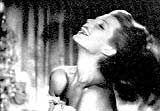 Mundson: "Gilda, are you decent?" 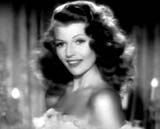 Gilda: "Me?"  Gilda: "Sure, I'm decent" |
|||||||||
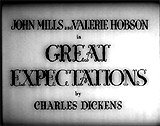
|
Great Expectations (1946, UK)
A truly scary and nightmarish scene occurred in the film's almost-silent, sweeping opening. Young Pip (Anthony Wager) was suddenly confronted, with a brilliant whip-pan camera movement, by bulbous-nosed convict Abel Magwitch (Finlay Currie). Pip was in a shadowy church graveyard visiting his parents' grave. The monstrous man threatened to cut the boy's throat and then demanded "a file and vittles." |
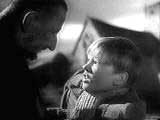 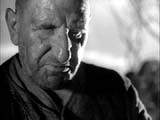
|
|||||||||
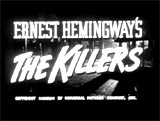
|
This acclaimed film noir featured the screen debut of Burt Lancaster - in his first screen role as washed-up, fatalistic ex-boxer the Swede, Ole Anderson/Pete Lunn. He remained reclined on his bed in his dimly-lit boarding house room, even though warned ahead of time to flee by co-worker Nick Adams (Phil Brown). The Swede was told that two killers had been at Henry's Diner, and were planning to shoot him when he came for supper. He responded passively: "There's nothing I can do about it." He dissuaded Nick from going to the police: "They wouldn't do any good...There ain't anything to do." And he didn't want to flee town: "I'm through with all that runnin' around." He was the complacent, indifferent and resigned target of assassins. He was ready to meet his fate, and admitted that in his past, he had made a mistake:
He calmly sat up in bed when he heard the two cold-blooded gunman-executioners entering his downstairs boarding house door before climbing the stairs, entering his room, and blasting him with multiple gunshots. |
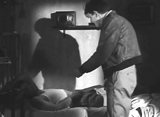 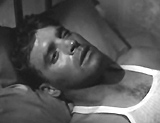 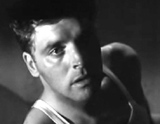 
|
|||||||||
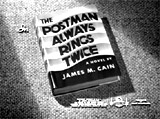
|
The Postman Always Rings Twice (1946)
Drifter handyman and mechanic Frank Chambers (John Garfield) took his first look at hot-blooded, voluptuous Cora (Lana Turner) -- not knowing she was the cafe boss' wife. Her sexy entrance was prefaced by her lipstick case noisily rolling across the floor of the cafe toward him. The camera tracked back to her nude slim legs in the doorway. Frank looked at all of her - she was provocatively sexy and scantily clad in white shorts, white halter top, and white turban. He set his eyes on the whitish platinum-blonde woman, bent down and picked up her lipstick, and asked: "You dropped this?"
She stood with her hand outstretched, waiting for him to bring it over to her. But he held onto her possession in the palm of his own hand and then leaned back on the counter. She strutted over and took the case out of his hand. She walked back to the doorway, stood sideways, and applied lipstick to her lips before shutting the door. |
||||||||||
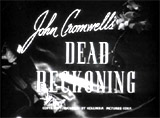
|
Dead Reckoning (1947)
Returning WWII military paratrooper veteran Capt. Warren 'Rip' Murdock (Humphrey Bogart) found his army buddy Sgt. Johnny Drake's (William Prince) blonde and treacherous ex-lover Mrs. Coral 'Dusty' Chandler (Lizabeth Scott). She was a cabaret lounge singer ("Cinderella with a husky voice") at the Sanctuary Club in a sultry Gulf City southern town. The camera panned up as she prepared to smoke a cigarette - and Rip held out a match to the alluring femme fatale. In voice-over, Rip reflected:
|
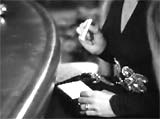 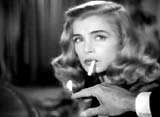
|
|||||||||
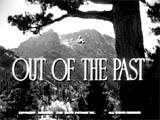
|
Jeff Markham's (Robert Mitchum) first sight of Whit Sterling's (Kirk Douglas) girlfriend/mistress Kathie Moffat (Jane Greer) confirmed Whit's earlier observation:
He memorably described how he first met the seductive femme fatale (when she first appeared in the film and walked into his life) dressed in white - but casting a sultry silhouette as she entered from the bright white, hazy outdoors into the dark Mexican cantina:
Immediately, Jeff was mesmerized and infatuated by the dark-haired beauty (seemingly so innocent) with a broad-brimmed, white hat - unaware of her lethal charms at the beginning of their ill-fated affair. |
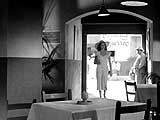 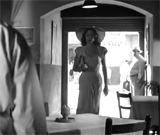 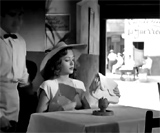 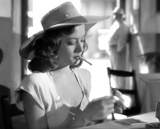
|
|||||||||
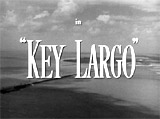
|
In his last major appearance as a gangster, Edward G. Robinson starred in this John Huston crime-drama as Prohibition-era mobster Johnny Rocco (known mysteriously at first as "Mr. Brown") -- modeled on real-life gangster Lucky Luciano. Rocco had just been deported to Cuba, but awaited a counterfeit deal with a Miami mobster while establishing temporary headquarters at a small Florida hotel in the Keys during the off-season where he had taken everyone hostage. The snarling racketeer's dramatic entrance, purposely delayed, found him partially obscured as he reclined in a bathtub, while smoking a cigar, drinking, and being air-conditioned by the revolving blades of an electric fan nearby. |
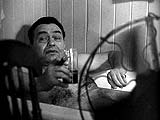
|
|||||||||
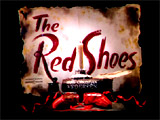
|
The Red Shoes (1948, UK)
Ballet impresario Boris Lermontov (Anton Walbrook) was introduced with a mysterious entrance scene. He was seated in the darkness behind the curtain of his opera box, with only his hand showing -- typical of the kind of entrances reserved for horror film characters. |
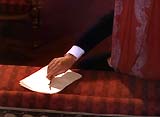
|
|||||||||
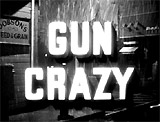
|
Three boyhood pals, including broad-smiling Bart (John Dall) with a troubled past, attended Packett's Carnival, passing by fire-eaters and belly dancers in the busy sideshows. They encountered "a great star act," featuring blonde, English sharpshooter Annie Laurie Starr (Peggy Cummins) - headlined by the seedy carnival owner/manager Packett (Barry Kroeger) as a hyped-up entertainer with a flamboyant past:
The entertaining star trick markswoman [a typical femme fatale seductress in film noir], filmed from below to make her appear more imposing, appeared on stage dressed as a Western cowgirl (with cowboy hat and shirt, gun holster, and hip-hugging black pants) and fired into the air with her smoking guns blazing in both hands. In the front row, Bart leaned forward intently for a closer look at his dream-girl/soul-mate come true, captivated and fixated on her domineering, gun-toting abilities that made her as good as any man. She lowered one of her guns and fired directly at her admiring, glazed-eyed customer, almost picking him out of the crowd. He reacted by flinching slightly - bewitchingly, she flashed a radiant, smiling grin back at him, revealing to everyone that she was using blanks in the potentially-potent gun. The audience applauded wildly for her attention-getting poses and presence. |
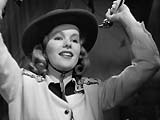 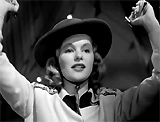 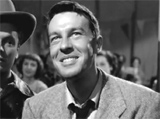 
|
|||||||||
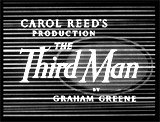
|
A scene dissolved to the street outside Anna's (Alida Valli) apartment, where Holly Martins (Joseph Cotten) walked away. He became aware of a figure in a doorway on the opposite side of the street when he saw Anna's cat in the shadows, snuggling next to a person's black shoes in a doorway. The cat was licking itself, and tipping off the presence of a silent and motionless person there. The figure's big shoes were illuminated - was it one of Calloway's men, Popescu, Kurtz, another thug or Intelligence agent? Holly abusively, drunkenly, and defiantly shouted out to the figure. A light from an irritated neighbor's upstairs window briefly illuminated the figure's face - shining straight across the street. Holly momentarily and suddenly saw Harry Lime (Orson Welles) - the 'third man' himself, an amoral blackmarketer. Amazed to see Harry still alive, Holly was startled by the flirtatious, mocking sight of the smiling, smug face of his friend staring back at him, with a raised eyebrow. The light was quickly extinguished, and before Holly could reach his friend, a car approached and blocked his path by coming between them. The figure made off and vanished to the sound of retreating footsteps in the dark. |
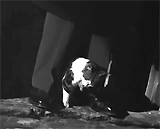 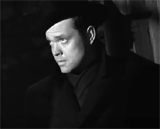 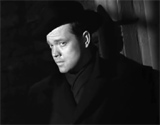 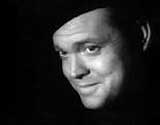
|
|||||||||
(chronological, by film title) Introduction | 1920s-1935 | 1936-1939 | 1940-1945 | 1946-1949 | 1950-1955 | 1956-1959 | 1960-1965 | 1966-1969 1970-1975 | 1976-1979 | 1980-1985 | 1986-1989 | 1990-1995 | 1996-1999 | 2000-2005 | 2006-Present |